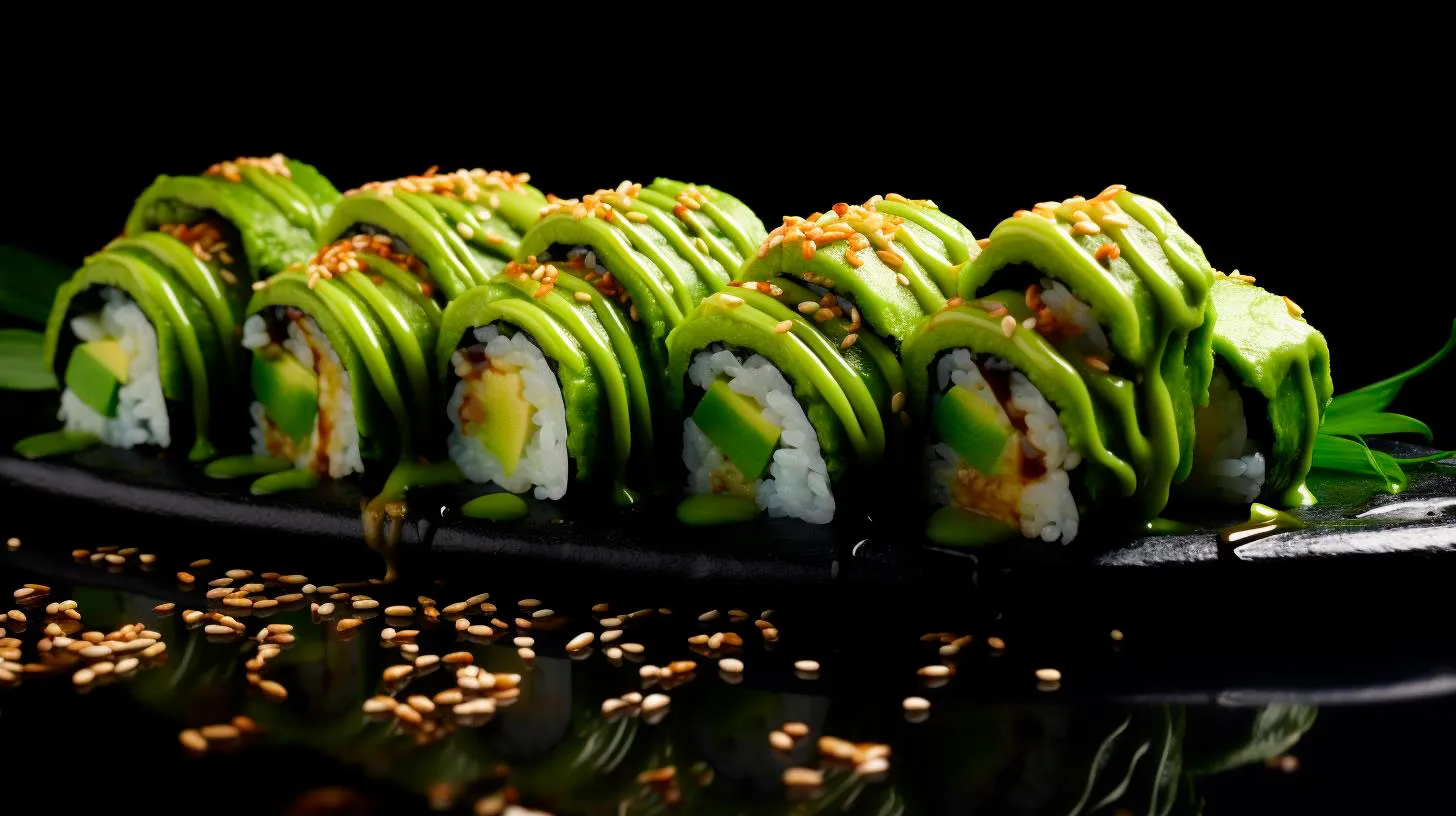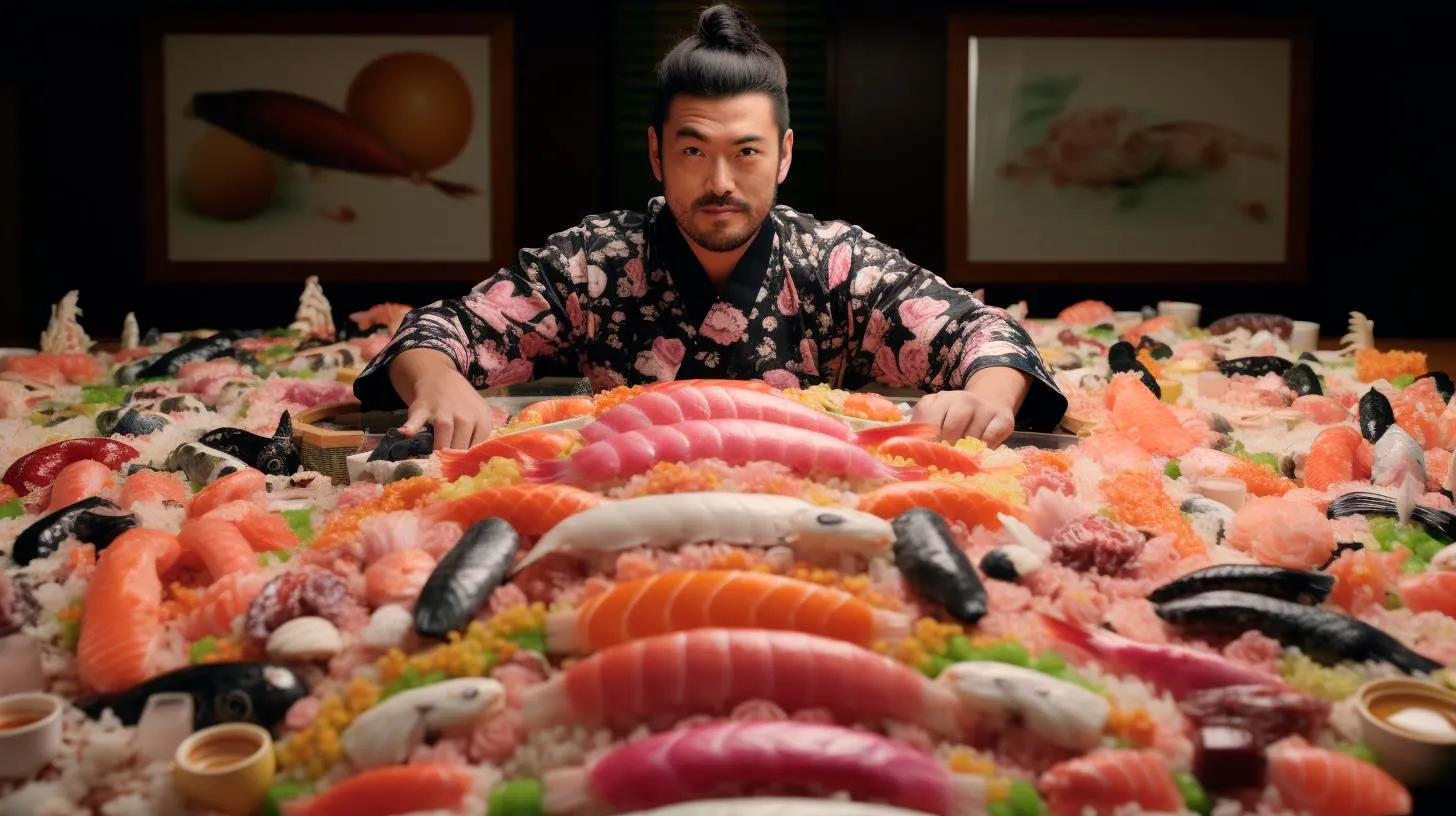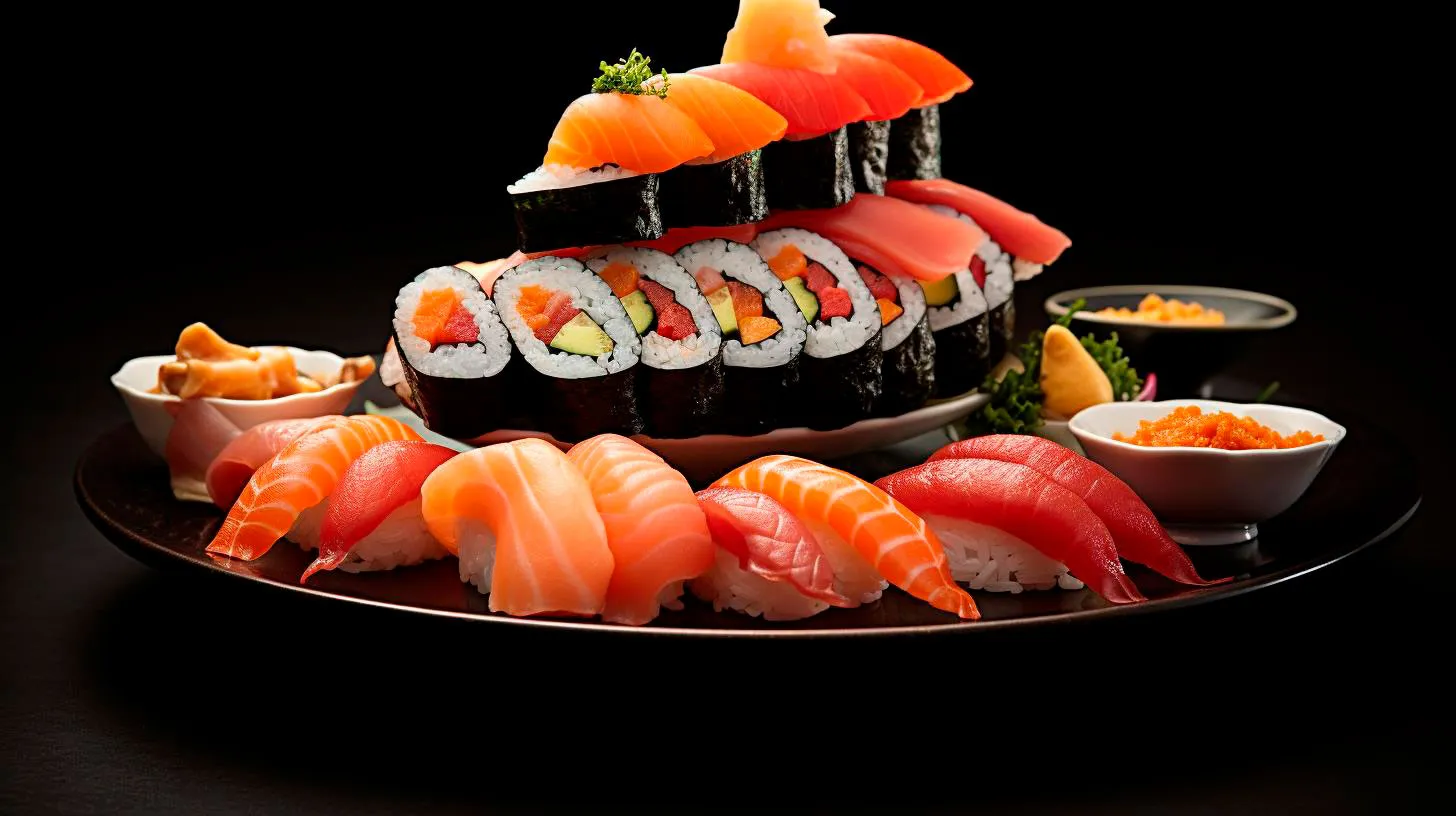Tobiko vs Masago: Choosing the Ideal Sushi Garnish
Two popular options frequently used by sushi chefs are tobiko and masago. In this article, we dive into the differences between tobiko and masago and help you decide which one is the ideal sushi garnish for your next meal.
What is Tobiko?
Tobiko is a type of fish roe that originates from flying fish. It is widely recognized for its vibrant orange color and small, delicate eggs. The crunchy texture and slightly sweet flavor make tobiko a beloved choice among sushi enthusiasts. Commonly used as a garnish, tobiko adds a delightful pop of color to sushi rolls and adds a crunchy contrast to the soft texture of the other ingredients.
Key characteristics of tobiko include:
- Small, crunchy eggs
- Vibrant orange color
- Slightly sweet flavor
- Commonly used as a garnish
What is Masago?
Masago, like tobiko, is a type of fish roe commonly used in sushi. However, unlike tobiko, masago is sourced from the capelin fish. Masago eggs are smaller and have a more delicate texture compared to tobiko. The color of masago varies depending on the processing method, ranging from vibrant orange to a paler shade of red or yellow.
Key characteristics of masago include:
- Smaller, delicate eggs
- Varied colors (orange, red, yellow)
- Mild and briny flavor
- Used as a garnish and in sushi rolls
Tobiko vs Masago: The Differences
While both tobiko and masago are fish roe used in sushi, there are several key differences between them:
- Origin: Tobiko is sourced from flying fish, while masago comes from capelin fish.
- Color: Tobiko has a vibrant orange color, while masago can vary in color, ranging from orange to red or yellow.
- Texture: Tobiko eggs are larger and slightly crunchier, while masago eggs are smaller and more delicate.
- Flavor: Tobiko has a slightly sweet flavor, whereas masago has a mild and briny taste.
- Usage: Tobiko is primarily used as a garnish to add color and texture, while masago can be used both as a garnish and as an ingredient in sushi rolls.
Choosing the Ideal Sushi Garnish
When it comes to choosing between tobiko and masago as a sushi garnish, it ultimately depends on personal preferences and the desired flavor profile. Consider the following factors to make an informed decision:
- Appearance: If you prefer a vibrant burst of color, tobiko’s orange hue may be the ideal choice for you.
- Texture: Tobiko’s larger eggs provide a satisfying crunch, while masago’s smaller eggs offer a more delicate textural experience.
- Flavor: If you enjoy a slightly sweet taste, tobiko is the way to go. However, if you prefer a subtly briny flavor, masago is your best bet.
- Usage flexibility: If you wish to experiment and use the roe as both a garnish and an ingredient, masago provides versatility.
Key Takeaways
- Tobiko and masago are popular fish roe used as sushi garnishes.
- Tobiko comes from flying fish, while masago is sourced from capelin fish.
- Tobiko has a vibrant orange color, while masago’s color can vary.
- Tobiko has a slightly sweet flavor, while masago has a mild and briny taste.
- Tobiko is mainly used as a garnish, while masago can be used as both a garnish and an ingredient.
- Your choice between tobiko and masago depends on appearance, texture, flavor, and desired flexibility of usage.
Ultimately, both tobiko and masago add a unique touch to sushi, elevating its visual appeal and providing a burst of flavor. So, next time you indulge in a sushi feast, consider trying both garnishes to experience the best of both worlds!
The Art of Tobiko and Masago Elevating Your Sushi Game
In particular, tobiko and masago are two ingredients that bring a burst of flavor, texture, and visual appeal to sushi rolls.
Tobiko: The Tiny Orange Gems
Tobiko is a type of flying fish roe that originates in Japan. With its vibrant orange color and delicate texture, it is often used as a sushi topping or garnish. Here are some interesting features of tobiko:
- Tobiko is rich in nutrients, including omega-3 fatty acids, which have numerous health benefits.
- It adds a delightful crunch to sushi rolls, creating a contrast of textures.
- The distinct, slightly sweet flavor of tobiko enhances the overall taste profile of sushi.
- It is commonly used in sushi rolls like the popular California roll or Dragon roll.
- Tobiko is visually appealing and adds a pop of color, making sushi more visually enticing.
Next time you order sushi, be sure to try a roll adorned with this delightful ingredient to experience the unique taste and texture it offers.
Masago: The Versatile Roe
Similar to tobiko, masago is also a type of fish roe that adds a burst of flavor to sushi. While tobiko comes from flying fish, masago is often sourced from smaller fish like capelin or smelt. Here are some key features of masago:
- Masago has a small, crunchy texture that enhances the overall mouthfeel of sushi rolls.
- It has a slightly milder and less sweet flavor compared to tobiko, allowing it to complement a wider range of sushi ingredients.
- It is often used as a garnish due to its vibrant orange color, adding visual appeal to sushi presentations.
- As with tobiko, masago is a good source of omega-3 fatty acids, which promote heart health.
- Popular sushi rolls that feature masago include spicy tuna rolls and volcano rolls.
By incorporating masago into your sushi, you can enjoy its unique crunch and subtle flavor, enhancing your overall dining experience.
Elevating Your Sushi Game
Now that you understand the characteristics and benefits of tobiko and masago, it’s time to explore how to incorporate these delightful ingredients into your sushi game. Here are a few suggestions:
Experiment with Flavors
Tobiko and masago offer sushi enthusiasts an opportunity to experiment with various flavors. Consider the following:
- Create a spicy mayo and tobiko roll by mixing spicy mayo with tobiko before adding it as a topping.
- Combine masago with diced avocado and cucumber for a refreshing and flavorful sushi filling.
- Add tobiko to your favorite sushi roll to introduce an exciting crunch and burst of sweetness.
Play with Texture and Color
One of the alluring aspects of sushi lies in its visual appeal. Adding tobiko and masago to your creations helps you play with texture and color, making your sushi visually stunning. Try:
- Sprinkling a layer of tobiko on the outside of a sushi roll to provide a striking appearance.
- Combining tobiko and masago together for a visually appealing mix of bright orange hues.
- Creating a sushi roll with alternating layers of tobiko and masago, adding texture and color with every bite.
Remember, presentation is key, and these ingredients can help you take your sushi presentation to the next level.
The Final Takeaway
Tobiko and masago are not only visually appealing but also elevate the flavor profiles of sushi. They offer unique bursts of flavor, delightful textures, and a vibrant visual experience. By incorporating these ingredients into your homemade sushi or exploring them when dining out, you can enhance your sushi game and enjoy an even more exquisite culinary adventure.
Secrets Revealed: How Tobiko and Masago Enhance Sushi Visual Appeal
These small but powerful ingredients not only add vibrant hues to the dish but also offer additional layers of flavor and texture. In this article, we will uncover the secrets behind how Tobiko and Masago enhance sushi’s visual appeal, as well as explore their advantages and key takeaways.
Tobiko: Bursting with Vibrant Colors and Flavors
Tobiko is the roe of flying fish, commonly found in Japanese cuisine. Its popularity stems from its eye-catching appearance and delicate taste. Tobiko comes in various colors, including orange, green, black, and even red, offering chefs a palette to create visually stunning sushi dishes. Here’s how Tobiko enhances the visual appeal of sushi:
- Colorful Impact: The vibrant colors of Tobiko instantly catch the eye, making the sushi visually appealing and enticing. The contrasting hues create a striking presentation, making each piece of sushi look like a work of art.
- Textural Delight: The small, crunchy roe of Tobiko adds an interesting and enjoyable texture to each bite. It pops and bursts under the teeth, creating a unique sensation that complements the other elements of sushi.
- Flavorful Burst: Tobiko has a mildly salty and slightly sweet flavor, enhancing the overall taste of the sushi. It adds an umami element to the dish, elevating the dining experience.
With its beautiful appearance, pleasing texture, and subtle flavor, Tobiko is an essential ingredient in sushi, elevating its visual appeal to a whole new level.
Masago: Tiny Gems of Flavor and Texture
Masago, another popular fish roe used in sushi, offers its own unique set of qualities that enhance the visual appeal of this beloved Japanese delicacy. Here’s how Masago makes sushi visually appealing:
- Subtle Elegance: Masago, often seen as small, glistening orange pearls, imparts a touch of elegance to sushi. Its understated appearance creates a sophisticated and refined presentation.
- Texture and Crunch: Just like Tobiko, Masago adds a delightful texture to each bite. The small pearls of Masago provide a burst of crunchiness, adding an exciting contrast to the sushi.
- Delicate Salinity: Masago carries a delicate salty flavor that enhances the taste of the sushi. Its subtleness adds a depth of flavor without overpowering other ingredients, resulting in a well-balanced creation.
With its elegant appearance, pleasant texture, and gentle flavor, Masago works harmoniously with other sushi components to amplify its visual appeal.
The Key Takeaways
When it comes to sushi, the visual appeal is just as important as the taste. Tobiko and Masago play significant roles in elevating the visual aesthetics of sushi, offering an array of advantages:
- Eye-Catching Colors: Tobiko and Masago add vibrant and contrasting colors, making sushi visually appealing and enticing.
- Textural Delight: Their small roe provide an enjoyable texture, adding an element of surprise to each bite.
- Flavor Enhancements: Both Tobiko and Masago contribute subtle flavors, elevating the overall taste of sushi while maintaining a delicate balance.
By incorporating Tobiko and Masago into sushi creations, chefs and sushi enthusiasts can elevate their culinary experiences to new heights.
As sushi continues to evolve and innovate, these tiny fish roe remain a vital part of its visual appeal. So, the next time you indulge in a serving of sushi, remember to appreciate the influence of Tobiko and Masago, and savor their delightful addition to this beloved culinary art form.
Tobiko and Masago: Exploring the Delicate Flavors of Sushi
In this article, we will delve into the world of tobiko and masago, exploring their delicate flavors and how they elevate the sushi experience.
Tobiko: Bursting with Flavor
Tobiko refers to the roe or eggs of flying fish, which are commonly found in Japanese cuisine. These small, vibrant eggs are known for their popping texture and distinct flavor profile. Here are some key features of tobiko:
- Tobiko eggs are small and crunchy, providing a delightful pop in every bite.
- These eggs come in a variety of colors, including red, orange, yellow, and black, due to different flavorings and seasonings.
- Tobiko has a subtly sweet and briny taste, complementing the overall flavor of the sushi.
Due to its unique characteristics, tobiko is commonly used as a garnish for sushi rolls, adding a burst of color and texture. The vibrant orange tobiko, known as “momiji tobiko,” is often used to enhance the presentation of sushi dishes.
Key Takeaways:
- Tobiko is the roe of flying fish.
- It has a crunchy texture and comes in various colors.
- Tobiko adds a subtly sweet and briny flavor to sushi.
Masago: A Delicate Touch
Similar to tobiko, masago is another type of fish roe commonly used in sushi. Masago specifically refers to the roe of capelin, an oily fish found in the North Atlantic Ocean. Here’s what you need to know about masago:
- Masago eggs are smaller compared to tobiko, with a slightly softer texture.
- These tiny eggs have a rich orange color and a mild, salty taste.
- Unlike tobiko, masago is often unflavored, allowing the natural taste of the fish eggs to shine through.
Due to its delicate flavor and smaller size, masago is often used as a topping or filling in sushi rolls, providing a subtle burst of saltiness. It is also popularly used to garnish sushi bowls and nigiri sushi.
Key Takeaways:
- Masago is the roe of capelin, an oily fish.
- It has a smaller size and a soft texture.
- Masago offers a mild, salty taste.
Combining Tobiko and Masago in Sushi
While tobiko and masago are distinct in their own ways, they can also be combined to create a flavorful and visually appealing sushi experience. Sushi chefs often use these two types of fish eggs together to create a harmonious balance. The combination of the crunchy texture from tobiko and the softer texture of masago adds depth to the sushi roll.
Whether they are used as a topping, filling, or simply for garnishing, tobiko and masago bring a unique flair to sushi. They not only enhance the overall taste but also provide an aesthetic appeal to the plating of sushi dishes.
In Conclusion
Tobiko and masago are two ingredients that sushi lovers should be familiar with. These tiny fish eggs add a burst of flavor and texture to sushi, elevating the dining experience. Here are the key takeaways from our exploration:
- Tobiko is the roe of flying fish, offering a popping texture and sweet, briny taste.
- Masago, the roe of capelin, has a delicate flavor and a smaller, softer texture.
- Combining tobiko and masago creates a harmonious blend of textures and flavors.
Next time you enjoy your favorite sushi roll, take a moment to appreciate the unique presence of tobiko and masago. These delicate fish eggs truly make sushi a culinary delight that tickles the taste buds.



